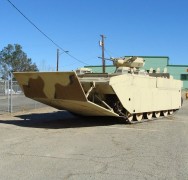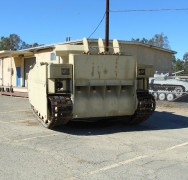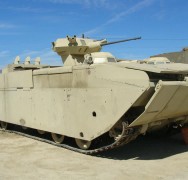GD EFV-P Prototype (Propulsion System Demonstrator)
The EFV would be an armored, fully tracked infantry combat vehicle operated by a three-person crew that can carry 17 combat-equipped Marines. It is to be a self-deploying, high-speed amphibious vehicle capable of transporting Marines from ships to objectives inland and aims to have the speed, maneuvering capabilities, fire power, and protection to operate with main battle tanks on land. It is intended to have a 20-knot speed in the water and a 345-mile range ashore with a 45-kilometer-per-hour speed on hard-surfaced roads. The EFV is to be designed to have modular armor and expanded mine blast protection and mount a 30mm high-velocity cannon in a stabilized turret. The EFV is also supposed to be able to communicate in joint networks and operate as part of a joint land force. There are to be two EFV variants. The EFV-P1 would carry a Marine rifle squad and its equipment and provide direct fire support during combat operations. The EFV-C1 variant would provide command and control capabilities for commanders and their staffs. The Mech’s EFV (1 of 3 personnel variants) was used in a 2006 Operational Assessment—a series of tests to demonstrate that it could meet performance requirements—that, if successfully completed, would permit the program to move into the production phase. During this assessment, the EFV experienced numerous critical failures and, because of repeated breakdowns, the EFV failed to meet reliability requirements and failed the assessment. For example, during the test, the vehicles were able to operate for only 4.5 hours between breakdowns and required about 3.4 hours of corrective maintenance for every 1 hour of operation—a maintenance burden that evaluators said would “wear out a unit under realistic combat operations.” Poor reliability also resulted in 117 Operational Mission Failures and 645 Unscheduled Maintenance Actions during testing. The EFV’s low reliability resulted in the EFV completing 2 out of 11 attempted amphibious tests, 1 out of 10 gunnery tests, and none of the 3 scheduled land mobility tests. The EFV prototypes tested were approximately 1,900 pounds too heavy to achieve the desired high water speed and, in some circumstances, could not accommodate equipment needed by Marines for special climatic conditions. Evaluators also noted significant problems in terms of limited visibility, excessive noise, and difficulty in reloading the EFV’s main gun. Jan 6/11: Canceled. As part of a plan detailing $150 billion in service cuts and cost savings over the next 5 years, Defense Secretary Robert Gates announces the cancellation of the USMC’s Expeditionary Fighting Vehicle (EFV):
“This program is of great interest to the Marine community so I would like to explain the reasons… Meeting [its conflicting requirements] demands has… led to significant technology problems, development delays, and cost increases… already consumed more than $3 billion to develop and will cost another $12 billion to build – all for a fleet with the capacity to put 4,000 troops ashore. If fully executed, the EFV – which costs far more to operate and maintain than its predecessor – would essentially swallow the entire Marine vehicle budget and most of its total procurement budget for the foreseeable future… recent analysis by the Navy and Marine Corps suggests that the most plausible scenarios requiring power projection from the sea could be handled through a mix of existing air and sea systems employed in new ways along with new vehicles… the mounting cost of acquiring this specialized capability must be judged against other priorities and needs.




